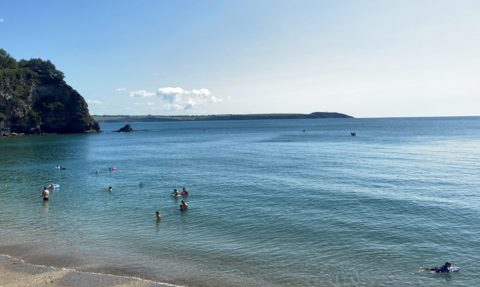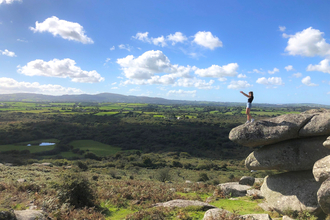
Our response to desalination plans
St Austell Bay is home to some of Cornwall’s most spectacular marine habitats. Its seagrass and maerl beds, among the largest in the UK, store carbon and support wildlife, including cuttlefish and the rare short-snouted seahorse. The bay’s marine environment is also important to the area’s economy, attracting visitors and supporting the local fishing industry. Yet, despite their significance, St Austell Bay’s seagrass and maerl beds currently have no statutory protection to prevent, or limit, damaging practices.
Cornwall Wildlife Trust is concerned that these habitats could be negatively impacted by South West Water’s proposals to construct and operate a water desalination plant in the area. Whilst we recognise the challenge South West Water faces in providing drinking water for an increasing population within a changing climate, we are calling on South West Water to ensure proposed developments do not negatively impact nature.
We have five specific asks:
- Demonstrate the need for a desalination plant
The high energy use of desalination as a method of drinking water provision, alongside other impacts of the plant and its operation, must be weighed-up against the corresponding demand. It is important for South West Water to justify the proposed desalination plant over alternatives, and to demonstrate this is the best option environmentally.
-
Engage closely with local communities and other key stakeholders
Communities have valuable local knowledge as well as legitimate questions about the proposed plans. We know there are widespread questions about the need for a desalination plant and, that there are concerns about potential impacts on maerl and seagrass. It is important for South West Water to deliver meaningful, open and constructive consultation both in-person and online.
-
Ensure the highest standards of environmental data collection and monitoring to inform plans
The specific impacts (negative or otherwise) of constructing and operating a desalination plant in St Austell Bay are currently unknown. Cornwall Wildlife Trust is calling on South West Water to ensure that no work is planned without first understanding potential risks to nature, with these being continuously monitored - throughout construction and operation. This understanding must be rooted in sound data and evidence.
-
Avoid damage to important habitats during any potential construction (most notably the bay’s seagrass and maerl beds)
Once robust, clear evidence is secured, it should be used to inform the design and construction of any proposed infrastructure. First, by avoiding all severe risks (for example, to irreplaceable habitats such as maerl), before minimising further threats, restoring habitats where damage has been done, and then – as a last resort – offsetting any residual impacts.
-
Demonstrate that the operation of the proposed plant will not significantly impact the area’s marine ecosystem
A key concern is that a potential future development phase of the plant could see hypersaline water (concentrated brine or very salty water) pumped into the bay once fresh water has been extracted. Cornwall Wildlife Trust is concerned that this could damage the bay’s ecosystem, threatening the seagrass and maerl beds. South West Water must secure credible data and evidence to demonstrate that the future operation of any plant would pose no threat to St Austell Bay’s seagrass and maerl beds.
Cornwall Wildlife Trust’s response
Cornwall Wildlife Trust’s response to the desalination plant is underpinned by one simple principle – to work for the best possible outcome for nature in Cornwall.
To achieve this, we are:
-
Constructively engaging with South West Water, providing evidence and advice to influence their plans
Over recent years, Cornwall Wildlife Trust, with our partners and volunteers, has worked to better understand the scale of St Austell Bay’s blue carbon habitats (habitats that capture and store carbon). We have actively shared the associated data and other evidence with South West Water, with the aim of avoiding and mitigating negative impacts on wildlife in the bay.
We are encouraged to see South West Water altering pipeline infrastructure plans as a result of specific evidence we have provided on the locations of seagrass and maerl beds.
But they still have more to do.
We continue to share data with South West Water. We also share this data with local groups concerned with the desalination plant’s development and with key stakeholders, including regulatory bodies and planning authorities responsible for reviewing and / or approving proposals. Influencing decision-makers to ensure the best environmental outcomes is a key part of our 2030 Strategy for Nature Recovery in Cornwall.
-
Holding South West Water to account
Where we feel South West Water could go further to avoid and mitigate the impacts of their proposals, we will make this clear. Cornwall Wildlife Trust is scrutinising and assessing South West Water’s plans, using a framework called ‘the mitigation hierarchy’ to ensure they are doing everything possible to avoid and minimise negative impacts to nature. Where we are not confident this is the case, we are objecting and / or calling on them to do better. We also continue to push for robust responses to our five asks listed above.
What you can do...
If you have questions or concerns about South West Water’s plans for a desalination plant, we recommend contacting the company directly.
-
Write to them at Freepost SWW desalination (no stamp required)
-
Email them at info@swwdesalination.co.uk
You can also help protect the area’s unique wildlife by getting involved with Cornwall Wildlife Trust’s Tor to Shore project or through a local environmental group.
(C) Matt Slater
Q&A
What is a desalination plant?
Desalination is the process of removing salt and other impurities from seawater to produce fresh water that is suitable for human consumption. Desalination is typically achieved in one of two ways:
(i) by heating seawater to separate the salts, or;
(ii) by passing seawater through membranes to separate the salts.
Both approaches are necessarily energy intensive and produce hypersaline brine as a waste product.
What is South West Water proposing and what are the potential impacts?
South West Water are currently proposing a two-phase development.
Phase one: This will involve construction of seawater abstraction infrastructure and a desalination plant at Par docks, a freshwater holding and treatment lagoon, an underground pipeline between Par and Restormel Water Treatment Works, and above ground pipelines between Par docks and Par Waste Water Treatment Works. Phase one is relatively small in scale and will only run at capacity during periods of water scarcity.
Importantly, phase one will combine desalination brine with treated wastewater (treated in line with permits issued by the Environment Agency), meaning that the discharge into the bay will not be hypersaline (i.e. not saltier than seawater). As such, Cornwall Wildlife Trust’s concerns regarding phase one relate mainly to the ecological impacts of construction.
Phase two: The specifics of phase two are currently less clear. We anticipate that it will be significantly larger in terms of volume of seawater processed, require the construction of a dedicated discharge pipeline in the bay and discharge hypersaline water (more salty than seawater) into the bay.
Cornwall Wildlife Trust would be especially concerned about the potential impacts of hypersaline discharge on the bay’s ecosystem. We already know that hypersaline water negatively impacts the growth and survival of seagrasses, and there are many documented impacts of brine on other species. For maerl, the impacts are entirely unknown.
Why is Cornwall Wildlife Trust not opposing the plant outright?
In June 2024 we sent a holding objection to the Marine Management Organisation (responsible for marine licencing) following South West Water’s application to conduct investigative drilling in the bay. Our objection was due to insufficient evidence being used for boreholes in areas containing seagrass, and the potential secondary impacts associated with drilling work. We will continue to review our position as new information becomes available.
Our intention is to engage constructively and openly with all stakeholders involved in this complex, multi-phase proposal. Cornwall Wildlife Trust is committed to evidence-based decision making throughout and, should the evidence suggest negative impacts are likely for specific aspects of the proposal, we will take action accordingly.
How does Cornwall Wildlife Trust work to protect nature in and around the bay?
Cornwall Wildlife Trust is deeply committed to protecting nature in St Austell Bay.
We:
-
Work with citizen science groups and organisations to collect data on marine wildlife and habitats, much of which now underpins what we know about the Bay.
-
Campaign and advocate locally and nationally for bigger, better, and more joined up marine protected areas.
-
Work with local communities to increase awareness of the bay’s importance, the threats facing its marine wildlife, and the actions we can take to protect it.
-
Through the Cornwall and Isles of Scilly Coastal Partnership, work collaboratively with the council, businesses, regulators, fishers, and other conservation organisations to protect our marine ecosystems.
What is Cornwall Wildlife Trust’s relationship with South West Water?
We have worked with South West Water on their Upstream Thinking initiative in other parts of Cornwall for many years. South West Water covers the costs of us working in several drinking water catchment areas to reduce agricultural pollution, encourage regenerative farming and enhance and restore habitats.
Our experience suggests we can secure the best outcomes for nature by engaging constructively with organisations outside the conservation sector, using our expertise and knowledge to positively influence policies and practices. Nevertheless, with any corporate partner, we always reserve the right to object to their activities if we feel they are in conflict with our aims.
Is there a risk to nature on land?
There will be risks to species and habitats on land with the proposed construction of a new pipeline. If sensitive habitats are avoided by careful route planning and advanced construction methods (for example drilling under Cornish hedges rather than removing sections) then the most significant impacts may be avoided. The terrestrial impacts are likely to be associated with construction rather than any on-going operation and there is established best practice for how to reduce these impacts. The detailed plans will need to be scrutinised, but we feel the risks to terrestrial habitats are lower than the risks to marine habitats.
Does the desalination plant impact plans for Tor to Shore?
Tor to Shore is a multi-faceted project focussed on enhancing wildlife and engaging people on our largest nature reserve, at Helman Tor, and with communities around St Austell Bay, as well as working in partnership with farmers on the land in between. With our overall aim of enhancing wildlife locally, the impact of the proposed desalinisation plant is relevant, particularly the potential impacts on important marine habitats.
We have learnt much more about the extent of the marine habitats whilst preparing the project bid over several years, so we are better equipped to challenge proposals that we feel fall short. Our strong connections with local community groups in the area also keeps us well informed. If desalination plans do progress during the lifetime of the Tor to Shore project, we feel that our evidence-based approach and our strong community links will help us to make sure that harm to important habitats is avoided and opportunities for enhancement are maximised.







